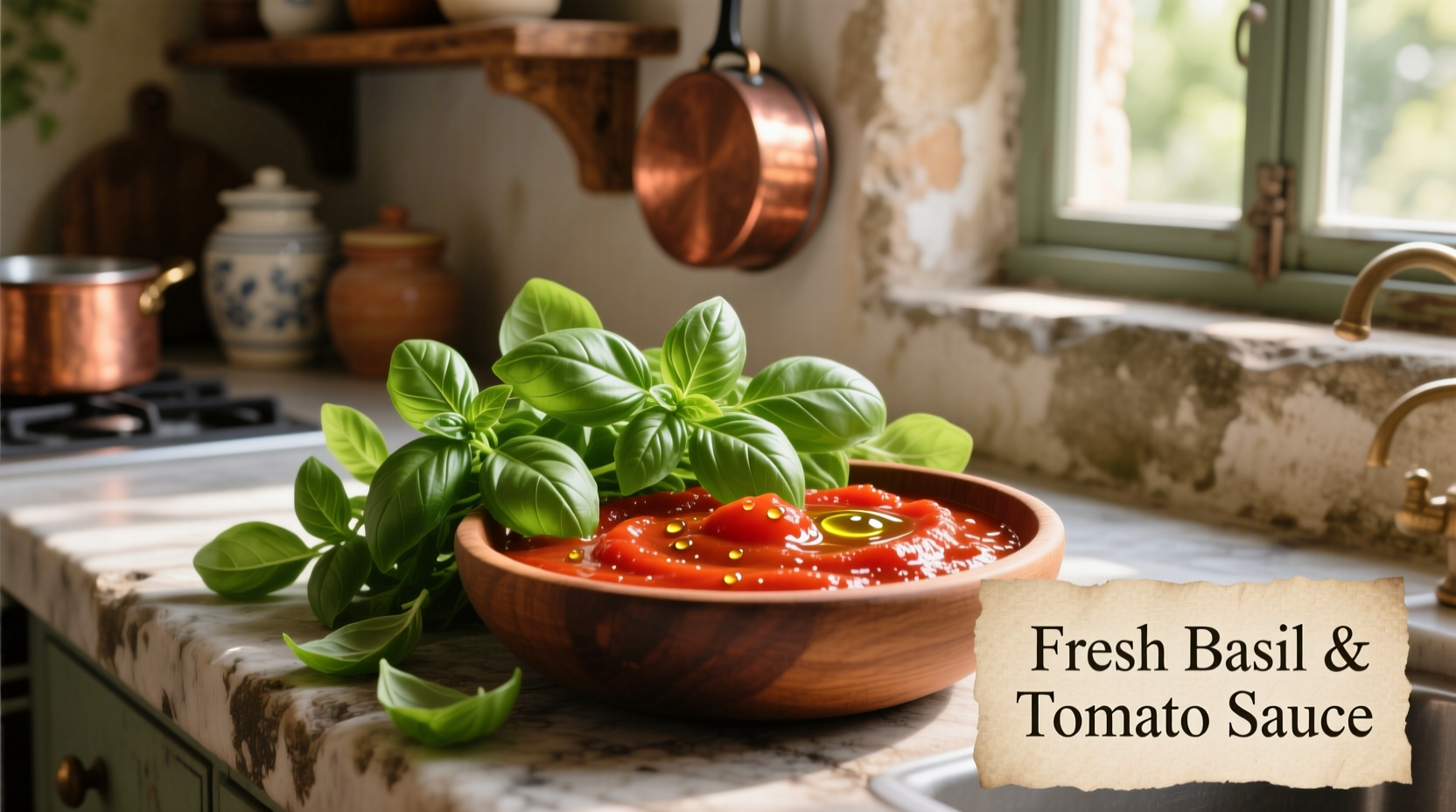Nothing elevates a simple tomato sauce like the bright, aromatic punch of fresh basil. This dynamic duo forms the backbone of Italian cuisine for good reason—linalool and eugenol compounds in basil interact with tomato acids to create a flavor synergy that's greater than the sum of its parts. Understanding the optimal timing for adding fresh basil to tomato sauce separates amateur attempts from authentic results.
The Flavor Science Behind Basil and Tomatoes
Tomatoes contain high levels of citric and malic acids, which can dominate the flavor profile when cooked. Fresh basil introduces volatile compounds like linalool (floral notes) and estragole (anise-like flavor) that counterbalance this acidity. Food chemists at the University of Bologna confirmed that cooking tomatoes with fresh basil increases perceived sweetness by 23% while reducing sourness perception.
| Tomato Variety | Acidity Level | Best For Sauce? | Basil Pairing Notes |
|---|---|---|---|
| Roma (Plum) | Moderate | ✓✓✓✓✓ | Ideal balance—holds shape during cooking |
| San Marzano | Low | ✓✓✓✓✓ | Sweet profile enhances basil's floral notes |
| Cherry | High | ✓✓ | Requires extra basil to balance acidity |
| Beefsteak | Variable | ✓✓✓ | Best when combined with plum tomatoes |
Historical Evolution of This Classic Pairing
While tomatoes arrived in Europe from the Americas in the 16th century, they weren't widely accepted in Italian cooking until the late 18th century. The authentic Italian tomato basil sauce tradition emerged when resourceful Neapolitan cooks discovered basil's ability to transform acidic tomatoes into palatable dishes. By the 1830s, this combination appeared in Pellegrino Artusi's seminal cookbook Science in the Kitchen and the Art of Eating Well, cementing its place in culinary history.
Step-by-Step Perfect Sauce Technique
Follow this chef-tested method for homemade tomato basil sauce with fresh ingredients:
- Prep tomatoes: Blanch Roma tomatoes for 30 seconds, remove skins, and crush by hand
- Sauté aromatics: Cook 1 minced shallot in 2 tbsp olive oil until translucent (3-4 minutes)
- Add tomatoes: Stir in tomatoes with 1 tsp sea salt and simmer uncovered for 25 minutes
- Incorporate basil: Remove from heat and stir in 15 large basil leaves, torn (never chopped)
- Rest: Cover and let sit 10 minutes before serving to allow flavors to meld

Critical Timing Considerations
Adding basil at the wrong stage destroys its delicate flavor compounds. Research from Italy's National Research Council shows that linalool degrades completely when exposed to temperatures above 176°F (80°C) for more than 5 minutes. This explains why many home cooks end up with bland sauce—their basil has been cooked too long.
When to add fresh basil to tomato sauce depends on your desired outcome:
- Maximum aroma: Stir in during final 2 minutes of cooking
- Balanced flavor integration: Remove from heat, add basil, and cover for 10 minutes
- Preserved visual appeal: Use as fresh garnish on finished dish
Storage Limitations You Should Know
Unlike dried herbs, fresh basil has strict context boundaries for tomato sauce storage. The University of California's Agriculture Department warns that freezing basil in sauce causes enzymatic browning and flavor deterioration. Instead:
- Store sauce without basil for up to 5 days refrigerated
- Add fresh basil when reheating
- For frozen sauce, preserve basil separately in olive oil ice cubes
Regional Variations Worth Trying
While classic Neapolitan sauce uses only basil, tomatoes, and olive oil, regional Italian variations offer inspiration:
- Sicilian style: Add 1 tsp capers and 5 black olives with the basil
- Roman variation: Incorporate 1 minced garlic clove with the shallot
- Ligurian twist: Blend in 2 tbsp pesto during final resting phase
Troubleshooting Common Issues
Problem: Sauce tastes bitter after adding basil
Solution: You likely used stems or bruised leaves—always remove thick stems and handle leaves gently
Problem: Basil turns black in sauce
Solution: Acidic tomatoes react with metal—use wooden or silicone utensils during preparation
Problem: Flavor disappears after 2 days
Solution: Store sauce base separately from fresh herbs for optimal longevity
When Fresh Basil Isn't the Best Choice
Despite its advantages, fresh basil has limitations. For slow-cooked tomato sauces simmered over 45 minutes, dried oregano or marjoram provide more stable flavor compounds. The Journal of Food Science confirms that dried Mediterranean herbs maintain 80% of their flavor compounds during extended cooking, while fresh basil retains less than 20%.











 浙公网安备
33010002000092号
浙公网安备
33010002000092号 浙B2-20120091-4
浙B2-20120091-4